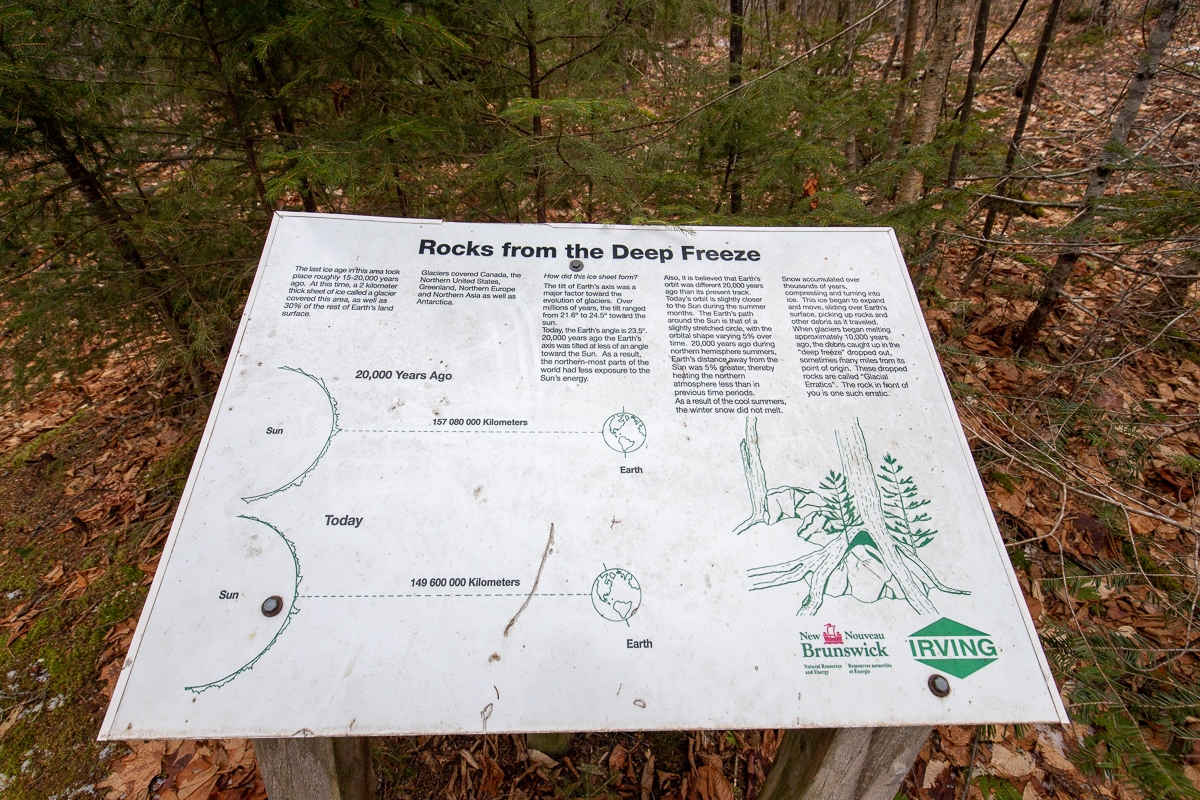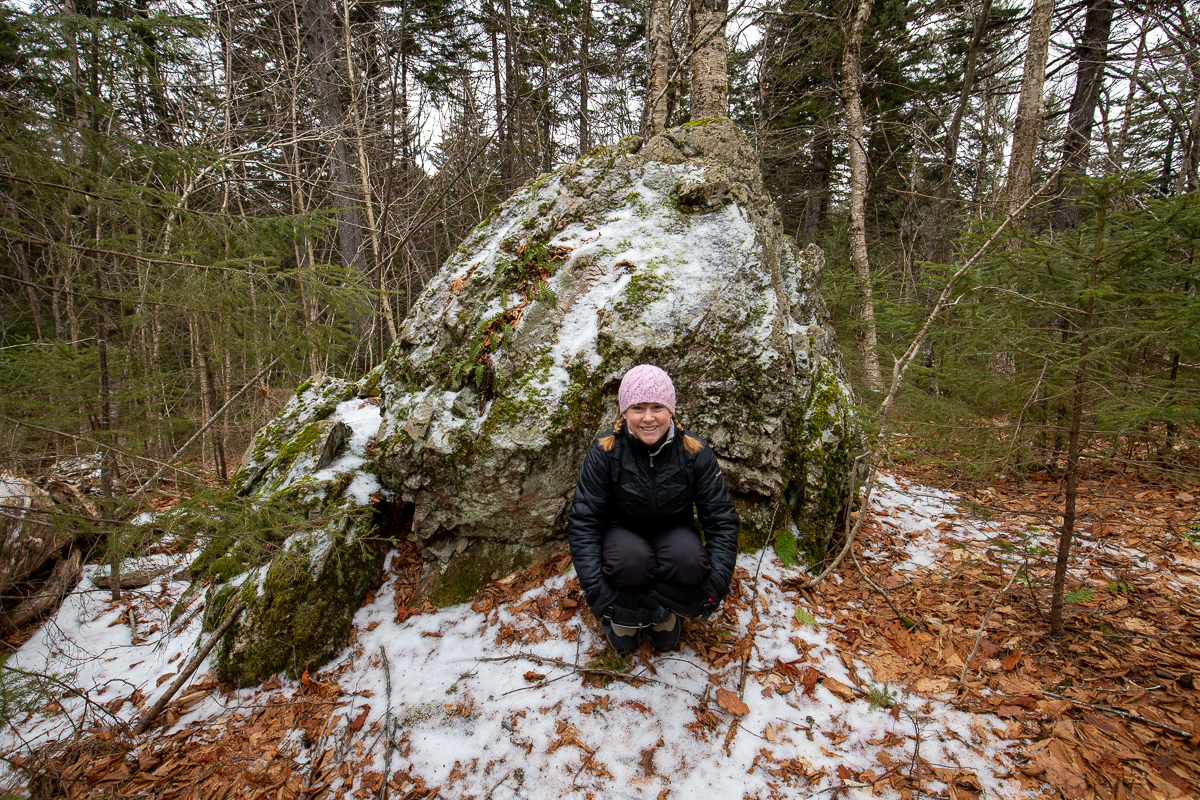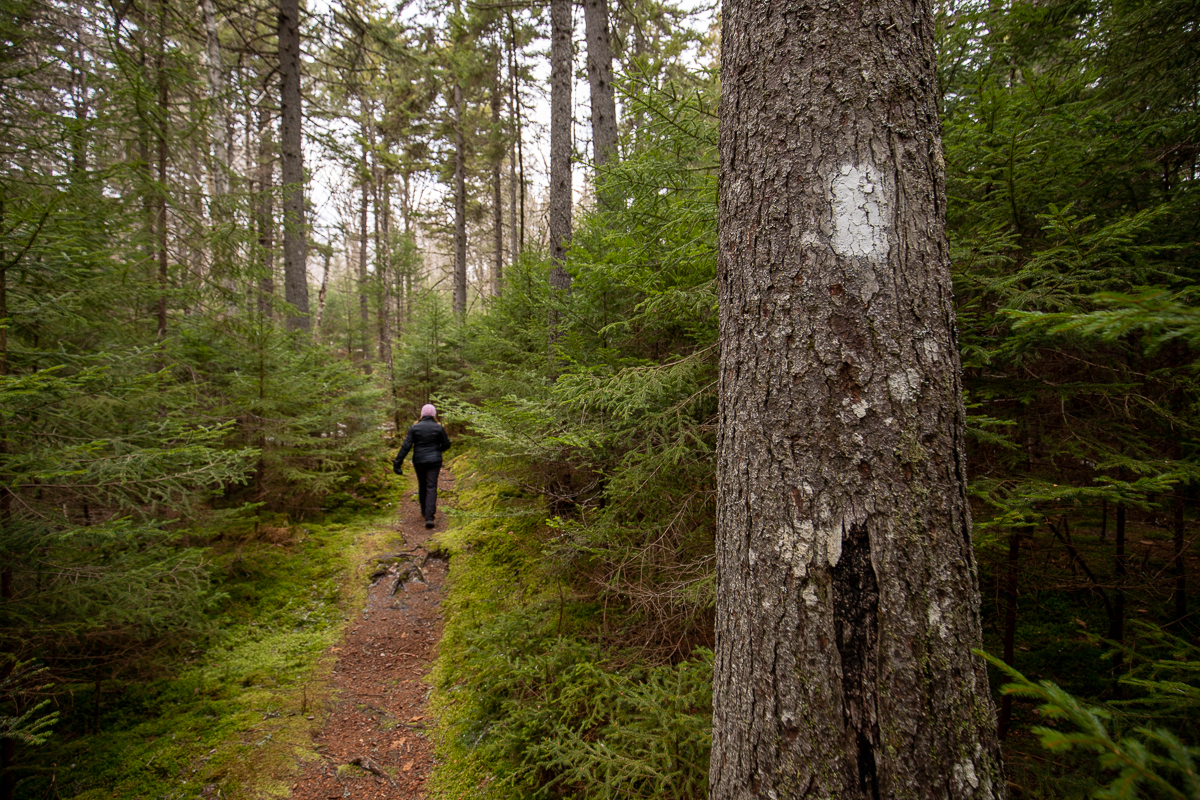Moss Glen Nature Trail
Map
Quick Facts
| Difficulty | moderate |
| Trail Type | loop |
| Distance | 2.2 km return |
| Estimated Time | 1 hour |
| Surface Type | forested |
| Elevation Change | 22 meters |
| Features | forest, rocks |
| Trail Markers | white squares |
| Scenery Rating | beautiful |
| Maintenance Rating | well maintained |
| Cell Reception | low |
| Dog Friendly | yes |
| Fees | none |
Directions
From the corner in Kingston, drive south on route 845 towards Quispamsis. Drive for about 10 kilometres along the shores of the Kennebecasis River. Almost across from the Kingston Fire Department turn right onto Williams Road. After about 800 meters you should see a wide spot for parking on the left side of the road. Park in the wide spot and cross the stream near the parking spot.
From the Sign
Rocks from the Deep Freeze
The last ice age in this area took place roughly 15-20,000 years ago. At this time, a 2 kilometer thick sheet of ice called a glacier covered this area, as well as 30% of the rest of Earth's land surface.
Glaciers covered Canada, the Northern United States, Greenland, Northern Europe and Northern Asia as well as Antarctica.
How did this ice sheet form?
The tilt of Earth's axis was a major factor toward the evolution of glaciers. Over millions of years, the tilt ranged from 21.6 degrees to 24.5 degrees toward the sun.
Today, the Earth's angle is 23.5 degrees. 20,000 years ago the Earth's axis was tilted at less of an angle toward the Sun. As a result, the northern-most parts of the world had less exposure to the Sun's energy.

Also, it is believed that Earth's orbit was different 20,000 years ago than its present track. Today's orbit is slightly closer to the Sun during the summer months. The Earth's path around the Sun is that of a slightly stretched circle, with the orbital shape varying 5% over time. 20,000 years ago during northern hemisphere summers, Earth's distance away from the Sun was 5% greater, thereby heating the northern atmosphere less than in previous time periods. As a result of the cool summers, the winter snow did not melt.
Snow accumulated over thousands of years, compressing and turning into ice. This ice began to expand and move, sliding over Earth's surface, picking up rocks and other debris as it traveled. When glaciers began melting approximately 10,000 years ago, the debris caught up in the "deep freeze" dropped out, sometimes many miles from its point of origin. These dropped rocks are called "Glacial Erratics". The rock in front of you is one such erratic.

From the Sign
Flying Jack - Pileated Woodpecker
Looking up the tree in front of you, you may notice a series of large (5cm x 8cm) rectangular holes in the tree. These were excavated by a crow-sized bird called a Pileated Woodpecker (Dryocopus pileatus), likely looking for a meal of insects within the tree. Its diet also may include nuts, such as acorns, sap, occasionally berries. A woodpecker's tongue is over twice as long as its beak and has a barbed tip that helps to extract the insects from their burrows in the wood. The bird's tongue is covered with extra sticky saliva to aid in retaining its prey.
The name Pileated comes from the Latin word, "capped", referring to the bird's bright red head cap. In addition to their large size head colour, their call is distinctive "cuk-cuk-cuk-cuk-cuk". Nests are excavated from tree trunks and generally found on the south or east side of trees as these positions usually provide the best protection from snow, rain, or wind.
How can you spot a nest or feeding site? Look for jellybean-sized chips of fresh wood at the base of large trees, then look up for the rectangular shaped cavity. Pileated Woodpeckers are year-round residents of this area

Description
The Moss Glen Nature Trail starts by crossing a small stream that runs along the Williams Road. After crossing the stream the trail climbs up to the right to a small opening that has two signs. One shows the trail supporters and the other shows a map of the trail. On the map there are four points of interest. These points of interest are marked by posts with a number nailed to them that corresponds to the point on the map.

The trail alternates between beautiful spruce forests with thick undergrowth, and hardwood ridges. Some of the older spruce trees are so large that you can only reach about half way around them. There are several large rocks along the trail. The largest is a 6 foot tall glacial erratic described in the "From the Sign" section below.
There are many other numbered posts along the trail with no description of what they are marking. We counted up to 16. There are also several other interpretive signs that describe the phases of a forest growth and the behaviours of the Flying Jack (Pileated Woodpecker).
The trail is a long narrow loop and near the back there is a small side trail to Wetmore Lake. This lake is on private property so tread lightly.
Podcasts
Episode 4: Counting at Moss Glen Nature Trail
Trail Last Hiked: December 29, 2019.
Page Last Updated: January 12, 2020.



